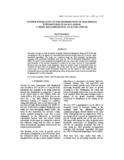| dc.contributor.author | Chowdhury, Navil | |
| dc.date.accessioned | 2010-10-10T04:05:35Z | |
| dc.date.available | 2010-10-10T04:05:35Z | |
| dc.date.issued | 2007 | |
| dc.identifier.uri | http://hdl.handle.net/10361/395 | |
| dc.description.abstract | This paper attempts to study the gender inequality situation in Bangladesh during 1995-96 through examining the effect the gender of a household head and their marital status has on the per capita household expenditure. The study was conducted using the Theil inequality decomposition technique with household expenditure data from the 1995-96 Household Expenditure Survey (HES). The study reveals that gender in Bangladesh does not seem to play a large role in explaining total inequality as the between component accounted for less than 5 percent of total inequality. However, this conclusion seems premature when the marital statuses of household heads are examined for their effect on inequality. The results show the need to distinguish amongst the various types of female headed households themselves. In this regard, De jure female headed households form an especially vulnerable group. Hence policy makers must keep this in mind when designing policy to reduce inequality. | en_US |
| dc.language.iso | en | en_US |
| dc.publisher | BRAC University | en_US |
| dc.relation.ispartofseries | BRAC University Journal, BRAC University;Vol.4, No.2,pp. 17-26 | |
| dc.subject | Inequality | en_US |
| dc.subject | Gender | en_US |
| dc.subject | Theil decomposition | en_US |
| dc.subject | Gini coefficient | en_US |
| dc.title | Gender inequality in the distribution of household expenditure in Bangladesh: a theil decompositon analysis | en_US |
| dc.type | Article | en_US |

